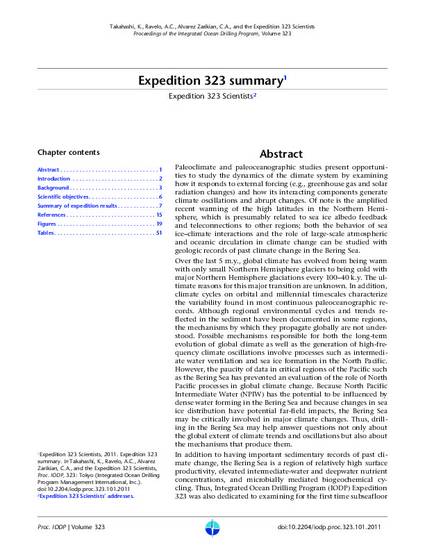
Presentation
Expedition 323 Summary
Proceedings of the Integrated Ocean Drilling Program
(2011)
Abstract
Paleoclimate and paleoceanographic studies present opportunities
to study the dynamics of the climate system by examining
how it responds to external forcing (e.g., greenhouse gas and solar
radiation changes) and how its interacting components generate
climate oscillations and abrupt changes. Of note is the amplified
recent warming of the high latitudes in the Northern Hemisphere,
which is presumably related to sea ice albedo feedback
and teleconnections to other regions; both the behavior of sea
ice–climate interactions and the role of large-scale atmospheric
and oceanic circulation in climate change can be studied with
geologic records of past climate change in the Bering Sea.
Over the last 5 m.y., global climate has evolved from being warm
with only small Northern Hemisphere glaciers to being cold with
major Northern Hemisphere glaciations every 100–40 k.y. The ultimate
reasons for this major transition are unknown. In addition,
climate cycles on orbital and millennial timescales characterize
the variability found in most continuous paleoceanographic records.
Although regional environmental cycles and trends reflected
in the sediment have been documented in some regions,
the mechanisms by which they propagate globally are not understood.
Possible mechanisms responsible for both the long-term
evolution of global climate as well as the generation of high-frequency
climate oscillations involve processes such as intermediate
water ventilation and sea ice formation in the North Pacific.
However, the paucity of data in critical regions of the Pacific such
as the Bering Sea has prevented an evaluation of the role of North
Pacific processes in global climate change. Because North Pacific
Intermediate Water (NPIW) has the potential to be influenced by
dense water forming in the Bering Sea and because changes in sea
ice distribution have potential far-field impacts, the Bering Sea
may be critically involved in major climate changes. Thus, drilling
in the Bering Sea may help answer questions not only about
the global extent of climate trends and oscillations but also about
the mechanisms that produce them.
In addition to having important sedimentary records of past climate
change, the Bering Sea is a region of relatively high surface
productivity, elevated intermediate-water and deepwater nutrient
concentrations, and microbially mediated biogeochemical cycling.
Thus, Integrated Ocean Drilling Program (IODP) Expedition
323 was also dedicated to examining for the first time subseafloor
biomass and microbial processes in high-productivity
regions.
The major objectives of Expedition 323 in the Bering
Sea are:
1. To elucidate a detailed evolutionary history of
climate and surface-ocean conditions since the
earliest Pliocene in the Bering Sea, where amplified
high-resolution changes in climatic signals
are recorded;
2. To shed light on temporal changes in the origin
and intensity of NPIW and possibly deeper water
mass formation in the Bering Sea;
3. To characterize the history of continental glaciation,
river discharges, and sea ice formation in order
to investigate the link between the continental
and oceanic conditions of the Bering Sea and
adjacent land areas;
4. To investigate, through comparison to pelagic records,
linkages between ocean/climate processes
that occur in the more sensitive marginal sea environment
of the Bering Sea and those that occur
in the North Pacific and/or globally. This objective
includes an evaluation of how the ocean/climate
history of the Bering Strait gateway region
may have affected North Pacific and global conditions;
and
5. To constrain global models of subseafloor biomass
and microbial respiration by quantifying
subseafloor cell abundance and pore water chemistry
in an extremely high productivity region of
the ocean. We also aim to determine how subseafloor
community composition is influenced by
high productivity in the overlying water column.
During Expedition 323 in the Bering Sea, 5741 m of
sediment (97.4% recovery) was drilled at seven sites
covering three different areas: Umnak Plateau, proximal
to where the modern Alaskan Stream enters the
Bering Sea; Bowers Ridge, in the open waters of the
Bering Sea and also proximal to the glacial Alaskan
Stream entry; and the Bering Sea shelf region, proximal
to the modern sea ice extent. Four deep holes
that range in depth from 600 to 745 m below seafloor
(mbsf) and generally span 1.9–5 Ma in age were
drilled. Some basement of older age was recovered at
one site (U1342). The water depths of the drill sites
range from 818 to 3174 m in order to characterize
past vertical water mass distribution and circulation.
The highlights of our findings include the following:
1. An understanding of the long-term evolution of
surface water mass distribution during the past 5
m.y., including the southward expansion of seasonal
sea ice to Bowers Ridge between 3.0 and 2.5
Ma and the intensification of seasonal sea ice at
both Bowers Ridge and the Bering slope at ~1.0
Ma (the mid-Pleistocene Transition);
2. The characterization of intermediate-water and
deepwater masses, including evidence from benthic
foraminifers and sediment laminations, for
episodes of low-oxygen conditions in the Bering
Sea in the last 5 m.y.;
3. The terrigenous and biogenic sedimentary history
of the Bering Sea, including evidence for
strong climatological and sea level control of siliciclastic
deposition at all sites. Records of lithostratigraphic
variations indicate that Bering Sea
environmental conditions were strongly linked
to global climate change; this is apparent both in
long-term, million year trends and in orbital,
millennial, and shorter oscillations within the
lithostratigraphic records generated at sea; and
4. A large range of inferred microbial activity with
notable site-to-site variations, including significant
activity as deep as 700 mbsf at the Bering
slope sites, and, in contrast, low rates of microbially
mediated sulfate reduction at Bowers Ridge.
Disciplines
Publication Date
2011
DOI
10.2204/iodp.proc.323.101.2011
Comments
Copyright 2011 Integrated Ocean Drilling Program Management International, Inc. Posted with permission.
Additional resources can be found at: http://publications.iodp.org/proceedings/323/323toc.htm
Citation Information
Kozo Takahashi, Ana Christina Ravelo, Carlos A. Alvarez Zarikian, Gilles Guèrin, et al.. "Expedition 323 Summary" Proceedings of the Integrated Ocean Drilling Program (2011) Available at: http://works.bepress.com/beth-caissie/14/
